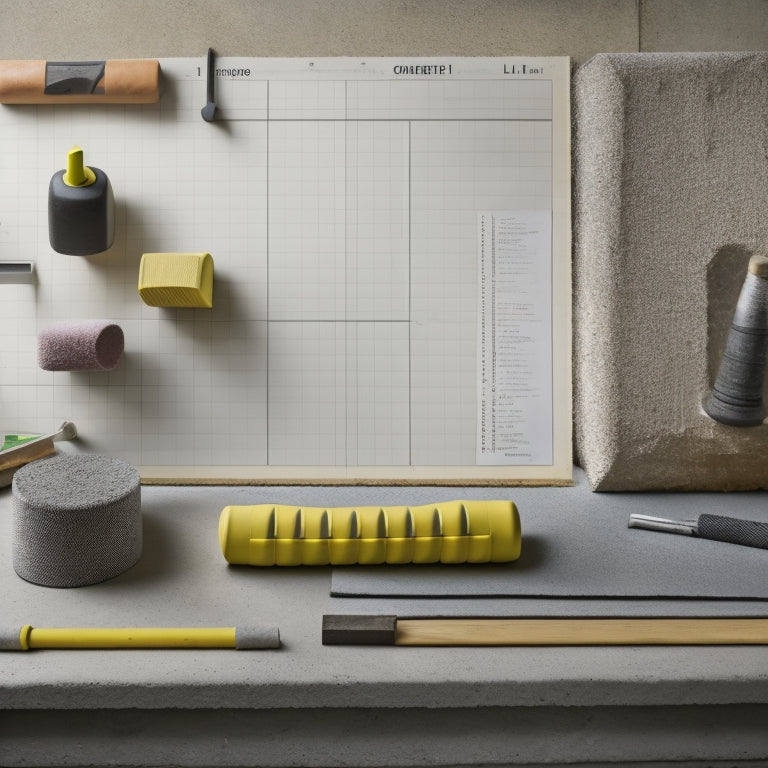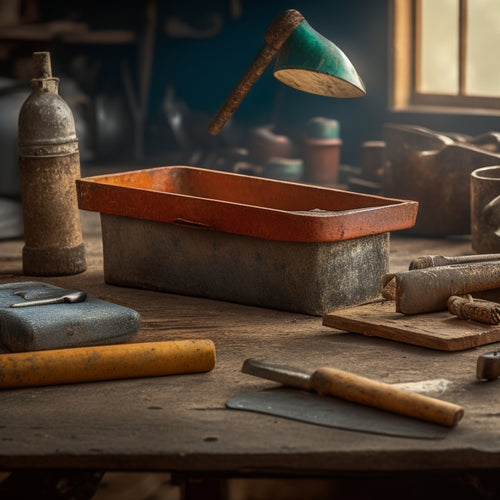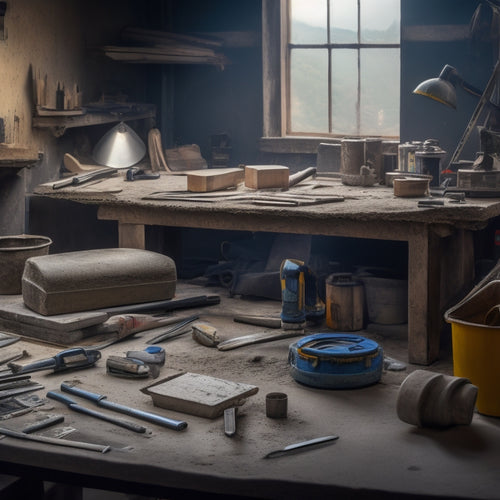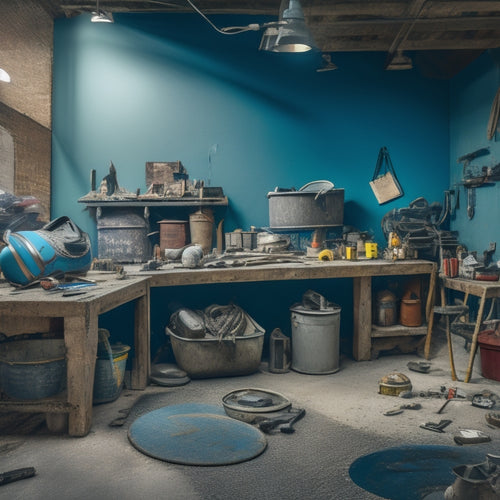
Budget-Friendly Tools for Laying Concrete Blocks
Share
You'll need a solid arsenal of tools to guarantee a successful concrete block laying project, and investing in the right ones doesn't have to break the bank. Start with fundamental tools like a trowel, level, and string line, which are essential for applying and smoothing mortar, securing block alignment, and maintaining straight lines. For tamping and leveling, consider a sturdy hand tamper or plate compactor, and a spirit level or laser level for accuracy. With the right budget-friendly tools, you'll be well on your way to a professional-looking concrete block project - and there's more to learn about the specifics of mixing, laying, and finishing that can make all the difference.
Key Takeaways
• A sturdy trowel is essential for applying and smoothing mortar, ensuring professional results without breaking the bank.
• Invest in a reliable level, such as a spirit level or laser level, to ensure accurate leveling and prevent errors.
• A mixing bucket, mixing stick, and measuring bucket are must-haves for mixing concrete, and can be found at an affordable price.
• A rubber mallet is a cost-effective accessory for gently tapping blocks into place without causing damage.
• Regular maintenance of tools is necessary to prolong their lifespan and ensure accuracy, saving you money in the long run.
Essential Tools for Beginners
You'll need a set of fundamental tools to get started with concrete block construction, including a trowel, level, and string line. These essential tools will help you achieve professional-looking results while safeguarding basic safety on the job site. A trowel, for instance, is essential for applying and smoothing out mortar, while a level verifies your blocks are perfectly aligned. A string line, on the other hand, helps you maintain a straight line and prevents deviations.
To get the most out of your tools, regular tool maintenance is important. Clean your trowel and level regularly to prevent mortar buildup and guarantee accurate readings. Store your tools in a dry place, away from direct sunlight, to prolong their lifespan.
Additionally, perform routine checks on your string line to make sure it's taut and secure. By following these simple maintenance tips, you'll be able to complete your concrete block project efficiently and effectively.
Affordable Tamping and Leveling
Your concrete block construction project requires precise tamping and leveling to guarantee a solid foundation, and affordable tools can help you achieve professional-quality results.
When it comes to tamping, you'll want to invest in a sturdy hand tamper or a plate compactor, depending on the scale of your project. These tools will help you achieve a compact, even surface, making sure your blocks fit together seamlessly.
For leveling, consider a spirit level or a laser level, which will give you precise readings and help you avoid costly mistakes.
Mastering tamping techniques and leveling strategies is essential for a successful concrete block project.
Start by tamping each block individually, working your way up in sections. Use a leveling tool to verify each block is perfectly aligned, and make adjustments as needed.
As you work, regularly check your progress to catch any errors early on. By combining the right tools with sound techniques, you'll be able to achieve a rock-solid foundation that will support your structure for years to come.
Budget-Friendly Mixing Essentials
With a solid foundation in place, attention now shifts to preparing the concrete mix that will bind your blocks together. Having the right budget-friendly mixing tools is vital to achieving a consistent, high-quality blend.
You'll need a sturdy mixing bucket, a reliable mixing stick or trowel, and a measuring bucket to guarantee accurate mixing ratios. Invest in a mixing paddle or electric mixer to streamline your mixing process and reduce fatigue.
Mastering mixing techniques is fundamental to achieving a strong, durable bond between your blocks. Start by mixing dry ingredients, then gradually add water while maintaining a consistent mixing pattern.
Avoid overmixing, which can weaken the concrete. Instead, aim for a workable consistency that's neither too dry nor too wet. By following established mixing ratios and techniques, you'll be able to create a high-quality concrete mix that meets your project's demands.
With the right tools and techniques, you'll be well on your way to laying concrete blocks like a pro, all while staying within your budget.
Cost-Effective Laying Accessories
Three essential cost-effective laying accessories - a level, a spirit level, and a rubber mallet - are must-haves for guaranteeing your concrete blocks are laid accurately and securely.
These tools help you achieve precise block laying, which is vital for a strong and durable structure.
To take your block laying to the next level, don't forget to:
** Regularly check and maintain your tools to confirm they're in good condition
** Use a level to verify your blocks are perfectly horizontal and vertical
-
Employ a spirit level to double-check your work and catch any minor deviations
-
Tap blocks gently into place with a rubber mallet to avoid damaging them
-
Clean your tools regularly to prevent mortar and debris buildup, making tool maintenance a breeze
DIY Concrete Block Laying
How do you guarantee a solid foundation for your DIY concrete block laying project? The key lies in a well-planned block wall design and attention to concrete block aesthetics. To confirm a sturdy base, you'll need to prepare the site by clearing debris, leveling the ground, and laying a compacted gravel base. Next, create a level string line to guide your block placement.
Here's a breakdown of the essential steps:
| Step | Description | Tips |
|---|---|---|
| Site Prep | Clear debris, level ground, and compact gravel base | Confirm a level surface |
| Lay First Course | Begin with a level course, using a spirit level and string line | Check for plumb and level |
| Lay Remaining Courses | Continue laying courses, overlapping blocks by 1/3 | Maintain level and plumb |
Frequently Asked Questions
Can I Use a Regular Shovel for Mixing Concrete?
You're wondering if a regular shovel will cut it for mixing concrete. The answer is, it depends on the shovel type and your mixing techniques.
A sturdy square-edged shovel can work for small batches, but a mixing shovel with rounded edges and a curved blade is ideal.
For efficient mixing, use a figure-eight pattern and scrape the sides of the mixing container.
However, for large projects, consider investing in a dedicated mixing tool for better results and to save your back.
How Do I Prevent Concrete Block Staining on My Clothes?
Like a warrior donning armor, you're about to protect yourself from the stains of battle - concrete block laying.
To prevent those pesky stains from ruining your clothes, you'll want to suit up with fabric protection. Wear old, durable clothing and consider investing in a waterproof apron or coveralls.
Apply a stain-repelling treatment to your fabric beforehand, and wash your clothes as soon as possible if you do get stained.
What Safety Gear Is Necessary for Laying Concrete Blocks?
When laying concrete blocks, you'll need to prioritize safety to avoid injuries.
First, you're wearing the right gear, which starts with proper footwear - sturdy boots with good traction to prevent slips and falls.
Next, don't forget protective eyewear, like safety glasses or goggles, to shield your eyes from flying debris and dust.
Can I Lay Concrete Blocks in the Rain or Snow?
You're about to initiate a concrete block-laying journey, but the skies are weeping tears of rain or whispering snowflakes of doubt.
Can you push forward, or should you wait for clearer skies?
Think of your concrete blocks as delicate flowers - rain's impact can wash away the bonding agent, and snow considerations demand a dry surface to guarantee a strong foundation.
Don't let the weather gods dictate your pace; wait for a dry, stable environment to guarantee your blocks stand tall and proud.
Do I Need a Permit to Lay Concrete Blocks on My Property?
You're likely wondering if you need a permit to lay concrete blocks on your property.
The answer depends on your local property regulations. Check with your municipal government to determine the permit requirements for your specific project.
Don't assume you're exempt - failure to obtain necessary permits can result in costly fines or even project shutdown.
Research and comply with local regulations to guarantee your project proceeds smoothly and legally.
Conclusion
As you wrap up your concrete block laying project, remember that having the right tools doesn't have to break the bank.
With these budget-friendly essentials, you've laid the foundation for a successful DIY endeavor.
Your sweat equity is the mortar that holds it all together, and with these affordable tools, you've built a strong case for taking on more ambitious projects.
Now, go forth and construct your own concrete castle, one block at a time!
Related Posts
-

Smart Guide to Buying Used Concrete Hand Tools
You're about to buy used concrete hand tools, and you need to get it right. Dedicate time to identify the tools you n...
-

3 Best Hand Tools for DIY Concrete Construction
When tackling a DIY concrete construction project, you'll need three essential hand tools to achieve a professional-l...
-

What Tools Do You Need for Concrete Flooring
You'll need a thorough arsenal of specialized tools to achieve a high-quality, professional-looking concrete floor, i...


